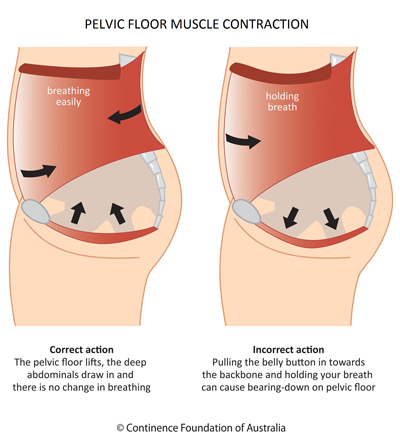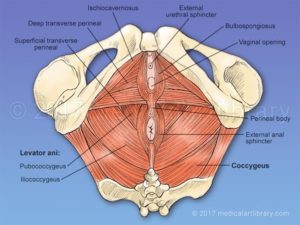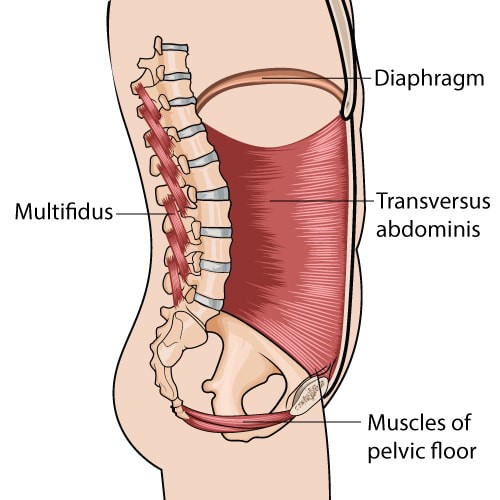Do you feel like you need to strengthen your core? This is one of the most common issues I am presented with by new clients.
When they say ‘core’, most of them are imagining their abdominal muscles, but many do not realise that the core is an entire set of muscles consisting of the pelvic floor (PF) the abdominal muscles and the diaphragm. To strengthen your core you need to make sure that all of the parts are working well together
Some have no idea what the pelvic floor looks like, or even where it is, let alone how its function is linked to core strength.
The PF muscles form the base of the group of core muscles, which along with the deep abdominal and back muscles and the diaphragm support the spine and control intra-abdominal pressure (IAP) – the pressure within the abdomen.
During movement and exercise, IAP changes. On exertion, the internal pressure increases, and when relaxing the internal pressure returns to normal.
Ideally, the regulation of pressure within the abdomen happens automatically. On exertion the core muscles work well together – the PF muscles lift, the abdominal and back muscles draw in to support the spine, and breathing is easy.
I coach my clients to close the holes in the pelvic floor in order to activate it. Imagine using your vagina like a straw, sucking up something, or trying to pick up a grape. It’s a gentle upward lifting action, gentle, not forceful.
This excellent video explains how
REF : Continence Foundation of Australia
When the muscles of your Pelvic Floor turn on, your TVA can engage properly.
If any of the core and PF muscles are weak or damaged, this coordinated automatic action may be altered. In this situation, during activity that increases the IAP there is potential to overload the PF causing depression and failure to engage the abdominal muscles as shown in the diagram below:
Breathing and Pelvic Floor Engagement
Proper breathing is incredibly important for healthy PF function. A deep breath that goes into the abdomen benefits the PF in many ways. To understand this, it is useful to understand the anatomy of the PF.
REF : Sharon Ellis Medical Art Library 2017
It is made up of three layers of muscles that attach to the left and right sitting bones, the pubic bone in the front, and the tailbone (coccyx) in the back. These four points are the diamond-shaped frame of the PF. The layers of muscles “hang” like a sling in the base of the pelvis, holding the organs.
When we breathe in, the PF receives the breath and the pressure of the downward-moving organs. This is because when we bring in air from the mouth or the nose, the lungs expand and the diaphragm muscle moves down towards the pelvic floor, pushing the organs down with it. As we exhale, the breath goes up and out. The organs also move up. A healthy PF stretches as we breathe in and contracts slightly as the breath goes up and out.
Note that PF muscles need to be flexible to work as part of the ‘core’, and they need to be able to relax as well as lift and hold. It is common for people to brace their ‘core’ and PF muscles exercise in the belief they are supporting the spine, but constant bracing can lead to them becoming excessively tight and stiff.
The final key players in core stability are the abdominal muscles. Of particular importance is the transverse abdominus (TVA,) the deepest abdominal muscle, which is like a corset that goes all the way around the lower torso, attaching at the bottom ribs. It lies underneath the rectus abdominis, internal obliques, and external obliques.
The fibres of the transverse abdominus are horizontal, which means when they’re contracted, they pull in the diameter of the abdomen (think of the image of tightening a belt). These muscles also serve a purpose in exhaling the breath.
REF Stacy Dockins
TVA is vital for maintaining postural stability through movement. Poor posture can lead to a weak TVA as well as make it challenging to take a deep breath, both of which can in turn be linked to PF issues.
- Sit in a neutral, tall position.
- Close your eyes and place your hands around your waist with fingertips toward the front of your belly.
- Imagine that you are blowing out birthday candles. Forcefully exhale. Do this several times. Get a sense of the muscle that is activating to create the pressure in your belly.
- Now do this again with a more in-depth, slower breath. Use the TA to force the very end of the exhale a bit longer. If you feel your waist getting smaller and your navel pulled in, you’ve got it.
KEY POINTS
- In order to strengthen your core you have to work on your abdominal muscles but also your pelvic floor
- Everything is connected, and deep belly breathing is the most efficient way to engage the TVA and take care of the pelvic floor.
- Your Transverse Abdominis AND Pelvic Floor muscles activate together
- DON’T FORGET to relax these muscles too -you CAN overuse them – don’t go around trying to hold in your tummy and pelvic floor all day – this will not make them stronger, they need to relax.

Rachel Law is a personal fitness trainer based in New Malden, Surrey. Qualifications: ActivIQ Level 3 Personal Training; Burrell Education Pregnancy Exercise Prescription; Burrell Education Advanced Pregnancy Wellness Practitioner; Burrell Education Advanced Post Natal Exercise Prescription; Burrell Education 3rd Age Women Optimal Health and Nutrition; Burrell Education Peri Natal Athlete; Burrell Education Pelvic Flow and Freedom; Olympic Weight Lifting; Premier Global Kettlebells; FIE Level Assessment and Mentoring



